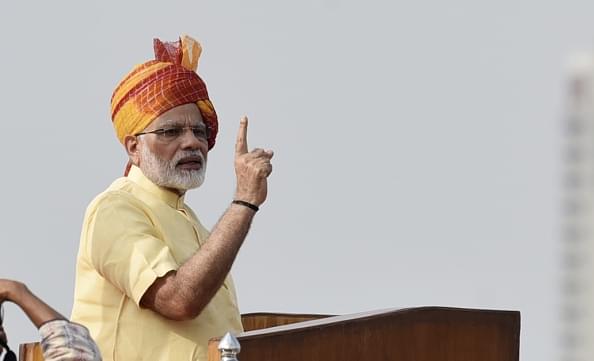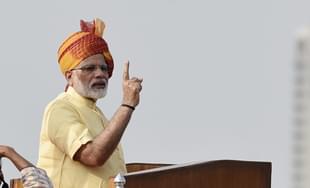Politics
Yes, It Is Possible To Change; But The Government Must Lead By Example
V Anantha Nageswaran
Aug 22, 2017, 11:49 AM | Updated 11:48 AM IST
Save & read from anywhere!
Bookmark stories for easy access on any device or the Swarajya app.


In his remarks on the 70th independence anniversary, Prime Minister Narendra Modi spoke eloquently of ushering in an India that was free from communalism, casteism, corruption, nepotism, poverty and terrorism. That is resolute. He could and should have added that India would, by 2022, be free of a system of governance that hinders the achievement of the above. It is important to stress the “system of governance” because the reference is not, in particular, to this government or even any particular state government. It is about the system. Nothing leaves a lasting imprint more than personal experience.
When one enters India these days, one sees the sign “Visa on Arrival” (VoA) at several international airports. The literal meaning of this is obvious. Or, so it seems. But nothing is what it appears to be. What one sees is maya; illusory. The reality has many more layers and it is as hard to glimpse as it is to glimpse true wisdom. It appears that the “Tourist Visa on Arrival” (TVoA) is really an e-visa. There is really no VoA. One has to apply in advance. How much in advance? Two or four days, depending on whom you speak to. But that is not the problem.
The problem is in knowing, with certainty, whether the scheme is in vogue, if so for what countries and at what airports. That is where the government of India takes you for a spin, and leaves you spinning forever. If you type “Tourist Visa on Arrival” on one’s internet search engine, a useful link (or so it seems) is a portal that comes with a bold and clear caption: “Tourist Visa on Arrival Scheme”. It is a document from July 2016 and it announces rather clearly, “The foreign nationals arriving from Finland, Japan, Luxembourg, New Zealand, Singapore, Cambodia, Vietnam, Philippines, Laos, Indonesia or Myanmar are required to fill a simple visa application form on arrival at the concerned airport provided by the Immigration Officer for the grant of Tourist Visa-On-Arrival (TVoA).” It also mentions eight airports where this TVoA is issued. This is where it starts to get curious.
This page provides, in more than one place, links to a document on the Union Ministry of Home Affairs website. This document is undated and it mentions only four airports in India (the four big metros) that offer this facility. It has not been updated to include four other airports. That is not the end of the problem. If you scour the website Mha.nic.in, you would find a “Foreigners Division” with some difficulty. Once you get there, a click or two later you would find a terse three-line announcement that VoA is available only for Japanese nationals. However, the website of the consulate general of India in Dubai echoes the web page (india.gov.in) above on the TVoA scheme and even provides a link to the one-page form that can be filled out on arrival and submitted along with a picture or two and $60 for a tourist visa. Did you notice the mistake?
Two bright spots amidst this welter of confusion. Bengaluru airport has a 24x7 WhatsApp service. At 1am Singapore time, they responded to my messages and gave a telephone number to call. The phone was answered. The answer was clear. There is no VoA at Bengaluru airport. The second bright spot was the Chennai airport immigration department. The phone was answered promptly and the message was that VoA was extended only to Japanese nationals.
Lest I am accused of picking on some departments based on personal experience, just try retrieving the Fourteenth Finance Commission report from the page of the commission itself or from the link from the Union Ministry of Finance website. While you are at it, check out the difference between dea.gov.in/datastatistic/public-finance-statistics and dea.gov.in/indian-public-finance-statistics. Finally, the Finance Ministry has two websites now, finmin.nic.in and mof.gov.in, and both look very different.
Now, the point here is not to make a “Letters to the Editor” complaint into a column. These errors – sloppiness – reflect what Prime Minister Narendra Modi called the chalta hai (everything goes) attitude among us. He called for badal sakta hai. Yes, it is possible to change. But what and whom? It has to start with personal change. That is where leadership by example comes into play. All of us and the government, above all, can set examples in our own ways. That is the durable way to effect change, not exhortation once a year.
Let it first start with the government getting the information content of its websites aligned, updated and consistent. Then, it can be extended to things like punctuality and respecting the rules that are applied to all citizens – from government permits to seats in schools, medical and engineering colleges, etc.
Accountability and the commitment of the government to it and to change will be reflected in such behavioural changes. There are more tangible ideas. The Economic Survey (Volume II) has one transformative idea. We will deal with that next week. This column set out to show that if the government could not get small things right, it would not inspire confidence that it would get geopolitical and geo-economic strategy right.
That is where the change must begin.
V. Anantha Nageswaran has jointly authored, ‘Can India grow?’ and ‘The Rise of Finance:Causes, Consequences and Cures’





